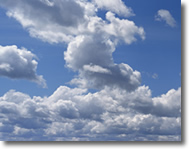Air Pollution
Download PDF Version What is PDF?
Table of Contents (TOC)
IntroductionChapter 1: Common Types of Air Pollution
Conclusion
Footnotes
Air pollution in the United States is a pervasive public health and environmental issue that costs the country billions of dollars annually in increased health care costs and environmental damage. This pollution also has significant potential to impact tourism (impaired visibility, regional haze) and other sectors (recreation, agriculture) due to impacts associated with anthropogenic (caused by human activity) -related global climate change.1
 There are several recognized categories of air pollutants that are
currently regulated by the federal and state governments, or are of concern to environmental and health scientists. The most important class of
pollutants are those regulated by the United States Environmental protection Agency (EPA) under the Clean Air Act (CAA) as primary air pollutants,
2 for which EPA is required to set a National Ambient Air Quality Standard (NAAQS). To date these
include sulfur dioxide (SOx), oxides of nitrogen (NOx), lead (Pb), carbon monoxide (CO), ozone, and particulate matter (PM). While ozone is not
emitted directly as a pollutant, it is formed in the atmosphere (during particularly hot weather) as the result of a reaction between volatile
organic compounds (VOCs) and NOx, (known as ozone “precursors”) in the presence of sunlight.
There are several recognized categories of air pollutants that are
currently regulated by the federal and state governments, or are of concern to environmental and health scientists. The most important class of
pollutants are those regulated by the United States Environmental protection Agency (EPA) under the Clean Air Act (CAA) as primary air pollutants,
2 for which EPA is required to set a National Ambient Air Quality Standard (NAAQS). To date these
include sulfur dioxide (SOx), oxides of nitrogen (NOx), lead (Pb), carbon monoxide (CO), ozone, and particulate matter (PM). While ozone is not
emitted directly as a pollutant, it is formed in the atmosphere (during particularly hot weather) as the result of a reaction between volatile
organic compounds (VOCs) and NOx, (known as ozone “precursors”) in the presence of sunlight.
Pollutants for which the EPA has established a NAAQS represent chemicals and compounds whose emissions are pervasive national health problems, with ambient air concentrations exceeding health-based standards in many areas of the country. These pollutants may also cause severe environmental damage, such as water body eutrophication3 and deforestation due to acid rain (associated with SOx and NOx emissions, primarily from large power plants, that combine with moisture in the air to form atmospheric nitric and sulfuric acid). Areas of the country which exceed the NAAQS for any primary pollutant are designated as in “nonattainment” with the standard, and must undertake certain CAA-mandated emissions control measures, depending on the severity of the exceedance. EPA is required to review the latest scientific information and, if necessary, revise these standards. New, more protective standards for ozone and fine particulate matter just took effect in 2004
Other significant pollutants of public health and environmental concern include:
Toxic compounds (EPA maintains a list of more than 100 toxics,4 officially referred to as hazardous air pollutants, or HAPs),
Mercury (Hg), dioxin, polychlorinated biphenyls (PCBs), and other compounds known as persistent bioaccumulators, whose presence builds up in the body due to prolonged exposure, and
Greenhouse gases, a class of compounds such as carbon dioxide (CO2) and methane, that result in global climate change.
 While air pollution comes from many sources, much of it is generated from processes related to energy use, transportation, and consumer products and equipment.
While air pollution comes from many sources, much of it is generated from processes related to energy use, transportation, and consumer products and equipment.
Broad source categories of air pollution emissions include:
Industrial and commercial sources such as power plants and factories (referred to as stationary sources),
Area sources, or smaller commercial facilities and operations, such as gas stations, dry cleaners, commercial and residential boilers (Area sources also include emissions from the use of consumer products, paint, and other products that release small amounts of pollutants during use or application), and
Transportation and equipment sources (such as cars, trucks, buses, airplanes, trains, etc., and associated refueling activities; construction equipment; marine and recreational vehicles; industrial equipment including forklifts, air compressors, and airport equipment etc.; lawn and garden equipment; diesel generators; and diesel particulate).
Power plants, building heat boilers, and air conditioning are significant contributors to NOx, SOx, carbon dioxide (CO2), fine particles, and mercury emissions.
Area sources individually have relatively small quantities of emissions. In the aggregate, however, they generate significant quantities of emissions due to the large number of such sources. Many consumer products including paints and personal products (such as hair spray, deodorant, etc.) release significant quantities of VOCs during application, drying, or curing.
The transportation sector is responsible for significant quantities of VOCs, NOx, CO, CO2, fine particles and toxics. (For example, the EPA has determined that diesel exhaust is a probable human carcinogen.)
 Reducing our energy consumption reduces pollution emissions and the demand for imported energy, particularly petroleum. How can we reduce energy use and air pollution?
Reducing our energy consumption reduces pollution emissions and the demand for imported energy, particularly petroleum. How can we reduce energy use and air pollution?
Drive more energy-efficient cars with low pollution engines
Choose energy-efficient appliances, such as those with the Energy Star label5
Purchase new, low pollution fuel-injected 2-stroke or 4-stroke recreational vehicles (snowmobiles, ATVs, motorcycles/dirt bikes, recreational marine engines, etc.)
Lower thermostats in the winter and raise them in the summer
Commute via car pool, public transit, bicycle, or walking
Maintain vehicles according to manufacturer recommendations (a well-tuned engine burns cleaner and pollutes less) and keep proper tire pressure
Use energy-efficient lighting and light bulbs
Shut off lights and other electronic devices when not in use
Another issue is the impact of transported air pollution, particularly in the northeast United States. Air pollution generated hundreds of miles away (particularly from tall smokestacks or large urban areas with great numbers of vehicles and high power consumption) may be carried by prevailing winds and be deposited (in the case of particles), or react to form other pollutants (such as ozone from transported NOx and VOCs), far downwind from where the pollution was actually emitted. Thus certain regions can take steps to reduce emissions yet still find that transported pollution causes the area to exceed air quality standards. For example, smoke particles from large forest fires, can often be measured hundreds or even thousands of miles downwind several days after the fire emissions are released. Scientist can track pollution from one area of the country to another, or even across continents (for example, smoke from the volcanic explosion from Mt. St. Helen or nuclear fallout from the Chernobyl accident were detected throughout much of Eastern Europe and in other parts of the globe for many weeks after the events).
 So while the traditional viewpoint is that industry and commercial operations account for most pollution, in reality it is you
and I in our daily activities that are responsible for most pollution! In fact, nearly one third to one half of many of the major
pollutants comes from the transportation sector. In the words of the cartoon character Pogo “We have met the enemy, and they is us…”.
So while the traditional viewpoint is that industry and commercial operations account for most pollution, in reality it is you
and I in our daily activities that are responsible for most pollution! In fact, nearly one third to one half of many of the major
pollutants comes from the transportation sector. In the words of the cartoon character Pogo “We have met the enemy, and they is us…”.
Footnotes


